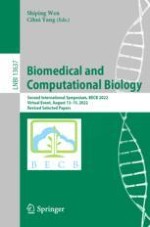This book constitutes the revised selected proceedings of Second International Symposium on Biomedical and Computational Biology, BECB 2022, held as a virtual event in August 2022.
The 58 full papers included in this book were carefully reviewed and selected from 135 submissions. The papers are organized in topical sections as follows: The Charge Transfer Network Model for Arbitrary Proteins Complexes; A Self-Supervised 3D/2D Registration Method for Incomplete DSA Vessels; The Potential Role of RNA "Writer" TRMT61B in the Immune Regulation of Breast Cancer; Extraction, Composition Analysis and Blood Lipid Lowering Activity of Rana chensinensis Ovum Oil.
